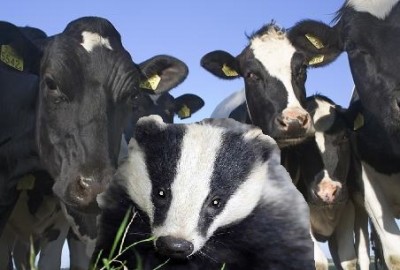 Now the badger culls are over and some of the results and analysis are starting to roll in, Chard Labour councillor and anti cull activist Graham Forsyth admits why as a Labour party member he agrees with Graham Godwin-Pearson of the right wing Tory think tank ‘The Bow Group’.
Now the badger culls are over and some of the results and analysis are starting to roll in, Chard Labour councillor and anti cull activist Graham Forsyth admits why as a Labour party member he agrees with Graham Godwin-Pearson of the right wing Tory think tank ‘The Bow Group’.
I did hear Graham speak along side Gavin Grant the RSPCA Chief Executive and Queen Rock Star Brian May at the Brewhouse Theater, Taunton in September 2012 while the badger cull was still being planned under Caroline Spelman’s short reign as the Forestry Commission estate agent and Environment Minster. Graham openly stated that the badger cull policy was a political disaster in the making for the Conservative party. Well Caroline Spelman has gone and surely its only a better of days before Owen Paterson goes after the sitting idly by as the Somerset Levels resemble the Bangladesh Delta!
Graham Godwin-Pearson now states that politics should be taken out of the situation and an extract of his report is detailed below:
The Bow Group’s report opposing the culling of badgers makes the following recommendations:-
1. Work with conservation charities to rollout a national injectable BCG badger vaccination programme, as per the recommendation of the EFRA Select Committee.
2. Implement compulsory pre-movement testing between farms within the same holding and prior to agricultural shows and common land grazing.
3. Compel farms that have TB to declare their status to neighbouring holdings.
4. Enforce isolation regulations and slaughter any new-born calves of reactors.
5. Increase the use of the g-IFN test, alongside the SICCT test.
6. Take the lead, alongside a major commercial herd, in field trials of a cattle vaccine, in order to aid the progression of legislation to permit the license of cattle BCG in Europe and trading of vaccinated cattle.
7. Appoint an Independent Panel on bTB to advise the Government on bTB policy direction now and in the future.
8. Push for more intuitive agricultural subsidies from the EU which incentivises good management rather than simply encouraging high yields.

My final comment of this situation is still: Having a Trade Association like the NFU which represents only 18% of farmers consisting mainly of the large landowners, dictating wildfire solutions is rather like the National Union of Teachers (NUT) suddenly deciding that they will be an extra month’s holiday included in the summer break, starting this summer so schools out for ten plus weeks, as the NUT control the Education Department!
This would be barking mad, yet the NFU are doing just that with our wildlife and DEFRA!
And we do not have a say in this matter. This is not democracy in action!
Farmers need a solution for the future that is going to last and the security of the food chain must be protected for the benefit of the whole nation and not just the vested interest of minority groups who perhaps have planning and other land management issues to promote.
Cllr Graham Forsyth
Chard

If a well-researched, well-argued post (on a Quaker site) is correct, of the 18% British farmers who are NFU members around half work in non-farming enterprises (within the finance and other business sectors). if true, then 9% British farmers have been given privileged access to ministers and influence on government agricultural and environmental policy, the government being content to ignore the interests of the remaining 91% farmers.
The NFU doesn’t seem to be accountable even to its own members. I tried to research its constitution and couldn’t – you have to join the NFU before you see what the rules are, whether members can influence NFU policy, etc.
I’ve seen suggestions that the NFU Council runs the NFU as these few individuals choose, ordinary members having no power to authorise or reject Council initiatives. It’s not easy for interested outsiders to find out whether such criticism of the NFU is soundly based.
errata – ‘which can contain 55 gallons of material’ should read: ‘which can process up to 55 gallons of material a day.’
You don’t need the Bow Group for the answer.
This is a précis of a talk given by
Steve Jones, Livestock Manager to GABS (Gloucestershire Against Badger Shooting) Noted by me
Steve a livestock manager with a life-time of experience managing herds of cattle as far apart as SW England, Norway and the Middle East told a meeting of Gloucestershire Against Badger Shooting in 2012 that the badger cull, announced by Government will not solve the problem of Bovine TB. What is needed is better husbandry of cattle and cow herds. He has never had an uncontrolled outbreak of Bovine TB (BTb) outbreak in the herds under his care.
Just as the spread of TB in humans is helped by overcrowding, poor air quality, diet, hygiene and stress so it is in cattle. The most common transmission method for Bovine TB is cow-to-cow. It is possible for it to be contracted from other mammals – including badgers, deer and humans. Direct nose-to-nose is unlikely, it is transmitted through a vector such as contaminated water, grass or bedding or soil. Simple hygiene could help prevent cows getting the disease in the first place and good management can prevent them spreading it to each other. Culling badgers is an irrelevance and will not stop the spread of Bovine TB.
Cows have been bred to produce milk and this makes them susceptible to respiratory disease. They have 4 stomachs – the largest of which is the rumen, which can contain 55 gallons of material – grass, water and saliva produced by the cow. The size of the traditional milk churn seen at the side of the roads is only 10 gallons. A cow’s stomach has 5 times the capacity of a milk churn. Because of the size of the stomach there is very little space in a cow’s rib-cage for lungs. This is why cows can’t run like horses – they haven’t the breathing capacity. So the quality of the air they breathe must be kept as good as possible.
The cow produces a phenomenal amount of saliva – as much as 20 gallons a day. She needs this much in order to turn the roughage in the green stuff she eats into energy to keep her going and into the huge amounts of milk she produces. Saliva is spread between cows, over the ground and as the cow feeds. When cows drink water the saliva is shared in the water container. If large troughs are used then there is greater sharing of possible infection. So Steve advocates the use of smaller water containers – which suits the cow’s social group behaviour as well.
Before the farming disgrace of Bovine Spongiform Encephalitis (BSE) in cattle and the foot and mouth outbreak, if TB was in a herd it was a real stigma for a farmer. Now there is complacency about it.
Cattle are usually kept indoors during the winter, and let out in the spring. It is vital at all times that the water troughs they drink from are cleaned out and that they are prevented from drinking water which can be contaminated with things like dead rodents and other animals, fallen leaves and animal droppings. The cow must not be allowed to share her water or feed supply with other mammals.
Cows kept indoors must be kept in well ventilated barns with plenty of air circulating around all areas of the building. Slatted sides, which allow air in from all sides are essential – because of the cattle’s vulnerable respiratory system.
Cows must also be well looked after – and all causes of stress prevented as much as possible. Stress has a big influence on health, as it can lead to damage of the immune system. The causes of stress range from other health problems – laminitis and mastitis (inflammation of the udder) – to handling by humans. Nearly a quarter of cattle in a herd typically suffer from laminitis, a painful condition of the hoof which leads to limping and should be treated. Mastitis too is very uncomfortable for the cow and must be picked up quickly. The fall in the price of milk has resulted in less resources being devoted to treating these diseases, which are rife in herds. The over-use of antibiotics also creates resistance and makes it harder to treat mastitis. When cows are handled to treat these diseases it must be done as efficiently and sympathetically as possible – again to reduce the effect of stress.
Quarantine is at present inadequate or non-existent on many farms, but when a cow reacts to the BTB test it is essential, and must be done sensitively because it will disrupt the social grouping of the herd, causing more stress. At the moment the testing regime is still weak, and there are too many false positives – the test needs to be improved.
The increased use of large scale factory farming of cows makes matters even worse for farming, as the huge volumes of muck produced by cows is spread over a whole area in a thick slurry, instead of lying in cow pats. Badgers, deer and other mammals are forced to walk over this infected mess and are likely to pick up Btb from the cows this way.
Reduction in the incidence of Bovine TB would be imminent if these measures were taken along with swift development of a vaccine and immunisation of cattle herds. The majority of badgers killed will be healthy.
Good recommendations…bravo for speaking up about the NFU too, that takes courage. You might find my recent speech given at the Birmingham badger rally interesting; the written version is here: http://www.scribd.com/doc/210214820/The-Crisis-in-British-Rural-Democracy Ama Menec Chair of TBVAC Devon wide badger vaccination.
What absolute sense.